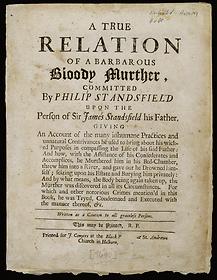Artifacts
A True Relation of a Barbarous Bloody Murther…, London, 1680s
In the 16th and 17th centuries, cultural entrepreneurs began to publish accounts of real murder cases, for sale to the public. These were often nothing more than printed transcripts of trials (sometimes with testimony by physicians or surgeons), or the confession of a murderer, occasionally with the addition of a crude engraving, but sometimes they featured reportage, with varying degrees of embellishment.
This sensational pamphlet, on the murder of Sir James Standsfield by his son Philip, reports that investigators in the case used a forensic test, based on the ancient belief that the corpse of a victim will bleed if touched by the murderer. After the surgeons had conducted the autopsy, they concluded that James Standsfield had been murdered, and sewed up his wounds. Philip Standsfield was then made to lift his father's body. The pamphlet states that blood from the fatal wound "sprung out upon Philip Standsfield's Hand," which was taken as a sign (from "the finger of God") that he was guilty—corroborating the considerable amount of circumstantial evidence which already weighed against him. Philip Standsfield was found guilty and hanged in the Edinburgh market square from a gibbet. As further punishment for the heinous crime of patricide (which was legally defined as "treason"), his tongue was cut out and burned on a scaffold, his right hand was cut off, and his body hung up in chains, all for public viewing. Scholars believe that the Standsfield case was perhaps the last in Scottish law to use the bleeding corpse test.
"In a secret Murther, if the dead carkasse be at any time thereafter handled by the Murtherer, it will gush out of blood; as if the blood were crying to Heaven for revenge of the Murtherer."
—Dæmonologie, King James VI, Scotland (James I of England)
